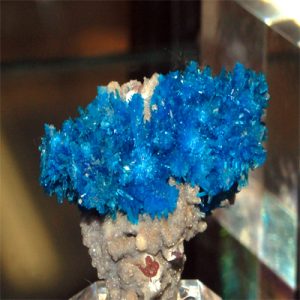Pentagonite
Pentagonite was discovered in the fall of 1960. Mr and Mrs Leslie Perrigo of Fruitland, Idaho found a blue mineral partly coating a large rock in a new roadcut near Owyhee Dam, Malheur County, Oregon. The chemical formula of Pentagonite is Ca(V4+O)Si4O1010 •4H2O (Hydrated Calcium Vanadate Silicate) and its molecular weight is 451.42 gm. Together with Mr and Mrs Frank Zimmerman of Payette, Idaho, they collected some of the material the following spring and sent it to Dr Paul Desautels of the United States National Museum, who reported that it was probably a new mineral. Pentagonite has a specific gravity of 2.33 (g/cm3) and a refractive index of 1.533 – 1.547. A crystallographic study proved this material to be a new mineral species and it was named Cavansite. During the crystallographic study, one small specimen from Owyhee Dam was found to contain crystals that were clearly twinned. These proved to be different from Cavansite. Although they have the very similar appearance and physical properties and the same chemical composition, crystal structure analysis showed the twinned crystals to be another new mineral species. The twinned material was named Pentagonite in allusion to the unusual pseudosymmetrical five-fold or pentagonal habit of the fiveling twinned crystals common in this species.
Because Pentagonite and Cavansite have a very similar appearance and physical properties and the same chemical composition but different crystal structures, they are dimorphs of each other. Both Cavansite and Pentagonite are orthorhombic with unit cells that are somewhat similar, but distinctly different. Ishida et al. (2009) suggest that Cavansite is a low-temperature form and Pentagonite a high-temperature form.
Distribution: Only two locations are known; the type locality at Owyhee Dam, Lake Owyhee State Park, Malheur County, Oregon, USA; Wagholi Quarry and Lonavala Quarry, Pune District (Poonah District), Maharashtra, India.
| Category: | Silicate mineral |
| Chemical Formula: | Ca(V4+O)Si4O1010 •4H2O |
| Hydrated Calcium Vanadate Silicate | |
| Molecular Weight: | 451.42 gm |
| Composition: | Calcium | 8.88 % | Ca | 12.42 % | CaO |
| Vanadium | 11.28 % | V | 20.15 % | V2O5 | |
| Silicon | 24.89 % | Si | 53.24 % | SiO2 | |
| Hydrogen | 1.79 % | H | 15.96 % | H2O | |
| Oxygen | 53.16 % | O | |||
| 100.00 % | 101.77 % | = TOTAL OXIDE |
| Crystallography: | Orthorhombic – Pyramidal |
| Crystal Habit: | Crystals prismatic, to 1 mm, with dominant {110}, {201}, and {001}, elongated || [001]; commonly as spherulitic rosettes, up to 5 mm |
| Twinning: | Cyclical by reflection across {110}; multiple twins result having pentagonal basal patterns closely simulating five-fold symmetry |
| Cleavage: | Distinct/Good; Good on {010} |
| Fracture: | n/a |
| Tenacity: | Brittle |
| Moh’s Hardness: | 3.0 – 4.0 |
| Density: | 2.33 (g/cm3) |
| Luminescence: | Not Fluorescent |
| Radioactivity: | Not Radioactive |
| Color: | Greenish Blue, Blue |
| Transparency: | Transparent |
| Luster: | Vitreous |
| Refractive Index: | 1.533 – 1.547 Biaxial ( – ) |
| Birefringence: | 0.014 |
| Dispersion: | Strong; r > v |
| Pleochroism: | Pronounced; X = Z = colorless; Y = blue |


